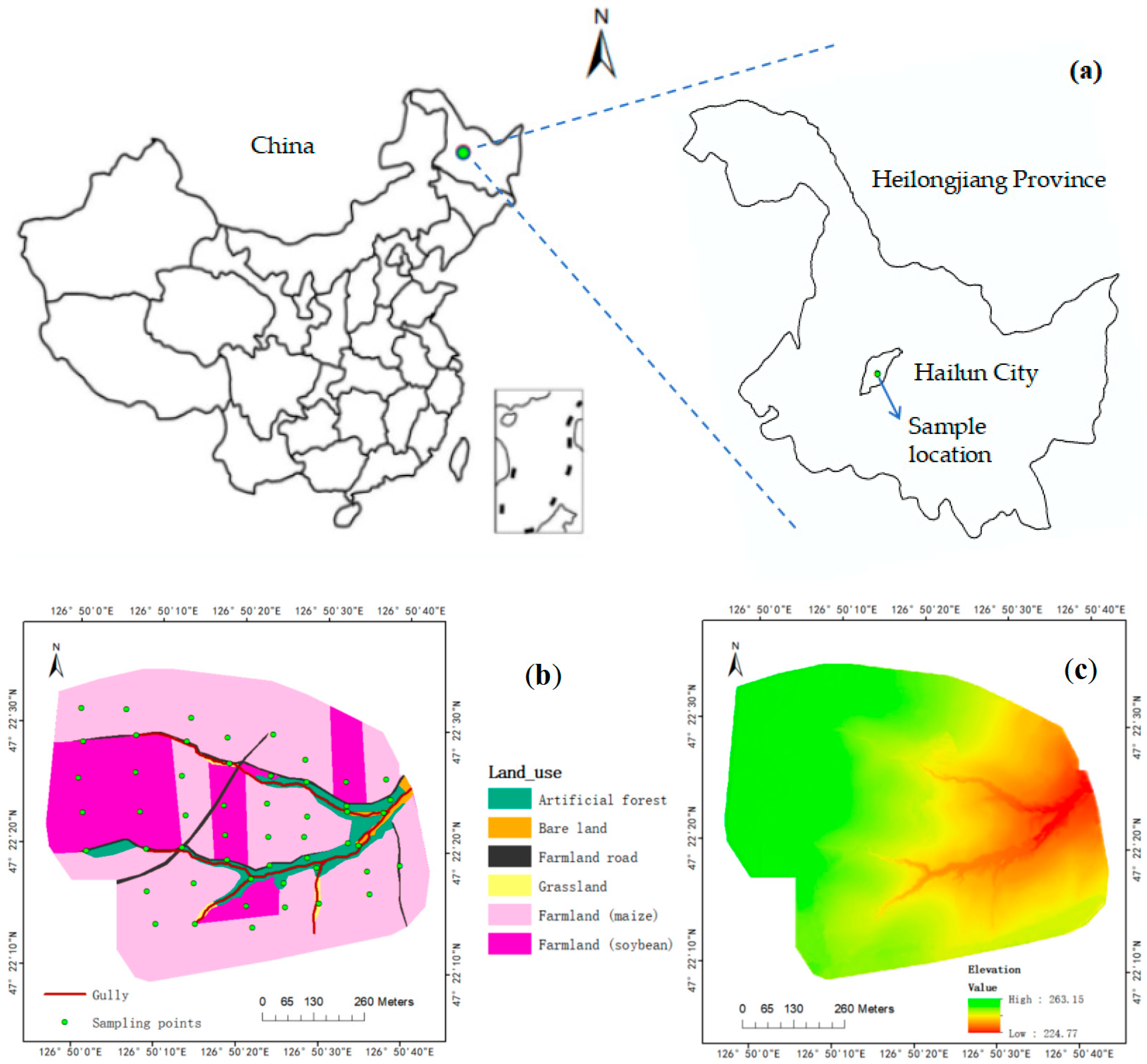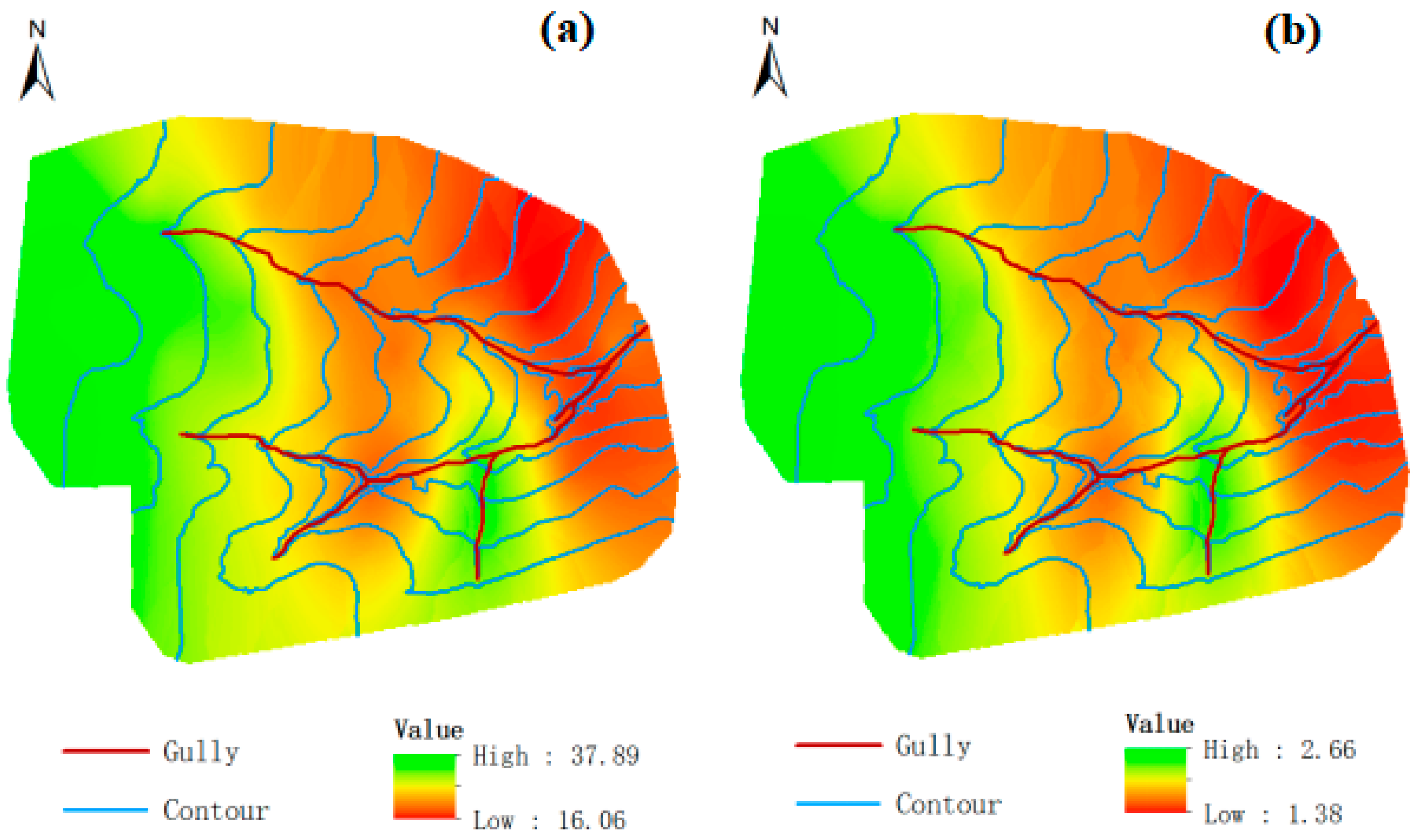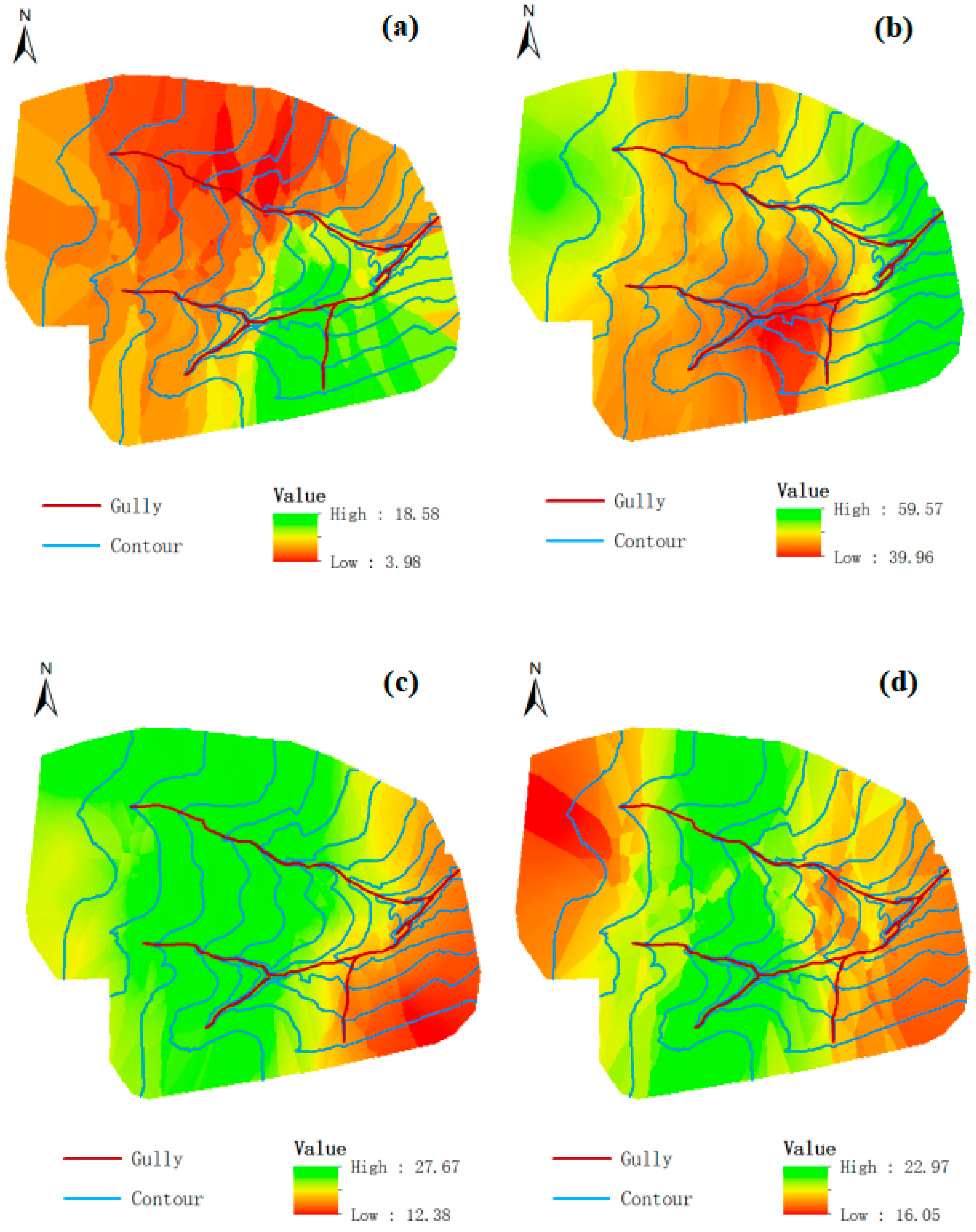Spatial Distribution of Soil Organic Carbon and Total Nitrogen in a Micro-Catchment of Northeast China and Their Influencing Factors
Abstract
1. Introduction
2. Material and Method
2.1. Study Area
2.2. Sampling and Measurement
2.3. Statistics and Geostatistical Analysis
- (1)
- The exponential isotropic model:
- (2)
- The Gaussian isotropic model:
- (3)
- Spherical isotropic model:
3. Results
3.1. Descriptive Statistics for SOC and STN
3.2. Spatial Distribution for SOC and STN
3.2.1. Geostatistical Analysis of Spatial Patterns in SOC and STN
3.2.2. Spatial Distribution
3.3. Influencing Factors for Spatial Distribution of SOC and STN
3.3.1. Soil Physical Properties
3.3.2. Topography
3.3.3. Land Use and Management
4. Discussion
4.1. Spatial Heterogeneity of SOC and STN
4.2. Factors Influencing Spatial Variation in SOC and STN
5. Conclusions
Author Contributions
Funding
Institutional Review Board Statement
Informed Consent Statement
Data Availability Statement
Conflicts of Interest
References
- Ogbonna, J.U. Understanding gully erosion vulnerability in Old Imo State using geographic information system and geostatistics. Am. J. Geogr. Inf. Syst. 2012, 1, 66–71. [Google Scholar]
- Shit, P.K.; Bhunia, G.S.; Maiti, R. Assessment of Factors Affecting Ephemeral Gully Development in Badland Topography: A Case Study at Garbheta Badland (Pashchim Medinipur, West Bengal, India). Int. J. Geosci. 2013, 04, 461–470. [Google Scholar] [CrossRef]
- IAbdulfatai, I.A.; Okunlola, A.I.; Akande, W.G.; Momoh, L.O.; Ibrahim, K.O. Review of gully erosion in Nigeria: Causes, impacts and possible solutions. J. Geosci. Geomat. 2014, 2, 125–129. [Google Scholar]
- Nekooeimehr, M.; Yousefi, S.; Emami, S.N. Identify the important driving forces on gully erosion, Chaharmahal and Bakhtiari province, Iran. In Computers in Earth and Environmental Sciences; Elsevier: Amsterdam, The Netherlands, 2022; pp. 191–197. [Google Scholar] [CrossRef]
- Maerker, M.; Sommer, C.; Zakerinejad, R.; Cama, E. An integrated assessment of soil erosion dynamics with special emphasis on gully erosion: Case studies from South Africa and Iran. In Proceedings of the 19th EGU General Assembly, EGU2017, Vienna, Austria, 23–28 April 2017. [Google Scholar]
- Pourghasemi, H.R.; Sadhasivam, N.; Kariminejad, N.; Collins, A.L. Gully erosion spatial modelling: Role of machine learning algorithms in selection of the best controlling factors and modelling process. Geosci. Front. 2020, 11, 2207–2219. [Google Scholar] [CrossRef]
- Xia, D.; Ding, S.-W.; Long, L.; Deng, Y.-S.; Wang, Q.-X.; Wang, S.-L.; Cai, C.-F. Effects of collapsing gully erosion on soil qualities of farm fields in the hilly granitic region of South China. J. Integr. Agric. 2016, 15, 2873–2885. [Google Scholar] [CrossRef]
- Ollobarren, P.; Capra, A.; Gelsomino, A.; La Spada, C. Effects of ephemeral gully erosion on soil degradation in a cultivated area in Sicily (Italy). Catena 2016, 145, 334–345. [Google Scholar] [CrossRef]
- Gregorich, E.G.; Carter, M.R.; Angers, D.A.; Monreal, C.M.; Ellert, B.H. Toward minimum data set to assess soil organic-matter quality in agricultural soils. Can. J. Soil Sci. 1994, 74, 885–901. [Google Scholar] [CrossRef]
- Bangroo, S.A.; Tahir Ali Mahdi, S.S.; Najar, G.R.; Sofi, J.A. Carbon and greenhouse gas mitigation through soil carbon sequestration potential of adaptive agriculture and agroforestry systems. Range Manag. Agrofor. 2013, 34, 1–11. [Google Scholar]
- Kosmas, C.; Gerontidis, S.; Marathianou, M. The effect of land use change on soils and vegetation over various lithological formations on Lesvos (Greece). Catena 2000, 40, 51–68. [Google Scholar] [CrossRef]
- Lal, R. Soil Carbon Sequestration Impacts on Global Climate Change and Food Security. Science 2004, 304, 1623–1627. [Google Scholar] [CrossRef]
- Bogunovic, I.; Pereira, P.; Coric, R.; Husnjak, S.; Brevik, E.C. Spatial distribution of soil organic carbon and total nitrogen stocks in a karst polje located in Bosnia and Herzegovina. Environ. Earth Sci. 2018, 77, 612. [Google Scholar] [CrossRef]
- Li, X.; Chen, Z.; Chen, H. Spatial Distribution of Soil Nutrients and Their Response to Land Use in Eroded Area of South China. Procedia Environ. Sci. 2011, 10, 14–19. [Google Scholar] [CrossRef]
- Bangroo, S.; Najar, G.; Rasool, A. Effect of altitude and aspect on soil organic carbon and nitrogen stocks in the Himalayan Mawer Forest Range. Catena 2017, 158, 63–68. [Google Scholar] [CrossRef]
- Zhang, X.; Li, X.; Ji, X.; Zhang, Z.; Zhang, H.; Zha, T.; Jiang, L. Elevation and total nitrogen are the critical factors that control the spatial distribution of soil organic carbon content in the shrubland on the Bashang Plateau, China. Catena 2021, 204, 1054175. [Google Scholar] [CrossRef]
- Zhang, S.; Han, X.; Cruse, R.M.; Zhang, X.; Hu, W.; Yan, Y.; Guo, M. Morphological characteristics and influencing factors of permanent gully and its contribution to regional soil loss based on a field investigation of 393 km2 in Mollisols region of northeast China. Catena 2022, 217, 106467. [Google Scholar] [CrossRef]
- Tang, W.-J.; Liu, H.-H.; Liu, B.-Y. Effects of gully erosion and gully filling on soil degradation in the black soil region of Northeast China. J. Mt. Sci. 2013, 10, 913–922. [Google Scholar] [CrossRef]
- Zhang, S.; Huffman, T.; Zhang, X.; Liu, W.; Liu, Z. Spatial distribution of soil nutrient at depth in black soil of Northeast China: A case study of soil available phosphorus and total phosphorus. J. Soils Sediments 2014, 14, 1775–1789. [Google Scholar] [CrossRef]
- Qi, Z.; Ding, C.; Han, X.; Zhang, X. Spatial heterogeneity of soil moisture and nutrients valley-slope erosion watershed in black soil area. Bull. Soil Water Conserv. 2020, 40, 79–87. (In Chinese) [Google Scholar]
- Zhao, B.; Li, Z.; Li, P.; Xu, G.; Gao, H.; Cheng, Y.; Chang, E.; Yuan, S.; Zhang, Y.; Feng, Z. Spatial distribution of soil organic carbon and its influencing factors under the condition of ecological construction in a hilly-gully watershed of the Loess Plateau, China. Geoderma 2017, 296, 10–17. [Google Scholar] [CrossRef]
- Li, Q.; Li, J.; Yu, M.; Guo, X. Spatial pattern of gully erosion control urgency in black soil farming area. Prog. Geogr. 2021, 40, 1208–1219. [Google Scholar] [CrossRef]
- Raju, N.J.; Shukla, U.K.; Ram, P. Hydrogeochemistry for the assessment of groundwater quality in Varanasi: A fast-urbanizing center in Uttar Pradesh, India. Environ. Monit. Assess. 2011, 173, 279–300. [Google Scholar] [CrossRef] [PubMed]
- Sun, T.; Chen, Q.; Chen, Y.; Cruse, R.; Li, X.; Song, C.; Kravchenko, Y.; Zhang, X. A novel soil wetting technique for measuring wet stable aggregates. Soil Tillage Res. 2014, 141, 19–24. [Google Scholar] [CrossRef]
- Gómez-Hernández, J.J. Geostatistics for Environmental Applications. Math. Geosci. 2015, 48, 1–2. [Google Scholar] [CrossRef]
- Bhunia, G.S.; Shit, P.K.; Chattopadhyay, R. Assessment of spatial variability of soil properties using geostatistical approach of lateritic soil (West Bengal, India). Ann. Agrar. Sci. 2018, 16, 436–443. [Google Scholar] [CrossRef]
- Wang, T.; Kang, F.; Cheng, X.; Han, H.; Bai, Y.; Ma, J. Spatial variability of organic carbon and total nitrogen in the soils of a subalpine forested catchment at Mt. Taiyue, China. Catena 2017, 155, 41–52. [Google Scholar] [CrossRef]
- Peng, G.; Bing, W.; Guangpo, G.; Guangcan, Z. Spatial Distribution of Soil Organic Carbon and Total Nitrogen Based on GIS and Geostatistics in a Small Watershed in a Hilly Area of Northern China. PLoS ONE 2013, 8, e83592. [Google Scholar] [CrossRef]
- Xu, L.; He, N.; Yu, G. Methods of evaluating soil bulk density: Impact on estimating large scale soil organic carbon storage. Catena 2016, 144, 94–101. [Google Scholar] [CrossRef]
- Wu, L.; Li, L.; Yao, Y.; Qin, F.; Guo, Y.; Gao, Y.; Zhang, M. Spatial distribution of soil organic carbon and its influencing factors at different soil depths in a semiarid region of China. Environ. Earth Sci. 2017, 76, 654. [Google Scholar] [CrossRef]
- McGrath, D.; Zhang, C. Spatial distribution of soil organic carbon concentrations in grassland of Ireland. Appl. Geochem. 2003, 18, 1629–1639. [Google Scholar] [CrossRef]
- Kang, E.; Li, Y.; Zhang, X.; Yan, Z.; Wu, H.; Li, M.; Yan, L.; Zhang, K.; Wang, J.; Kang, X. Soil pH and nutrients shape the vertical distribution of microbial communities in an alpine wetland. Sci. Total. Environ. 2021, 774, 145780. [Google Scholar] [CrossRef]
- Liu, W.; Qiao, C.; Yang, S.; Bai, W.; Liu, L. Microbial carbon use efficiency and priming effect regulate soil carbon storage under nitrogen deposition by slowing soil organic matter decomposition. Geoderma 2018, 332, 37–44. [Google Scholar] [CrossRef]
- McLauchlan, K.K.; Hobbie, S.E. Comparison of Labile Soil Organic Matter Fractionation Techniques. Soil Sci. Soc. Am. J. 2004, 68, 1616–1625. [Google Scholar] [CrossRef]
- Chen, S.; Chen, Q.; Sun, T.; Zhang, G.; Zhang, X. Effects of Straw Mulching on Topsoil Structure and Air Permeability in Black Soil Sloping Farmland. Bull. Soil Water Conserv. 2016, 36, 17–21. (In Chinese) [Google Scholar] [CrossRef]
- Zhang, S.; Zhang, X.; Huffman, T.; Liu, X.; Yang, J. Influence of topography and land management on soil nutrients variability in Northeast China. Nutr. Cycl. Agroecosyst. 2010, 89, 427–438. [Google Scholar] [CrossRef]
- Bot, A.; Benites, J. The Importance of Soil Organic Matter: Key to Drought-Resistant Soil and Sustained Food Production (No. 80); Food and Agriculture Organization: Rome, Italy, 2005. [Google Scholar]
- McCool, D.K.; Brown, L.C.; Foster, G.R.; Mutchler, C.K.; Meyer, L.D. Revised Slope Steepness Factor for the Universal Soil Loss Equation. Trans. ASAE 1987, 30, 1387–1396. [Google Scholar] [CrossRef]
- Yair, A.; Klein, M. The influence of surface properties on flow and erosion processes on debris covered slopes in an arid area. Catena 1973, 1, 1–18. [Google Scholar] [CrossRef]
- Fu, X.; Shao, M.; Wei, X.; Horton, R. Soil organic carbon and total nitrogen as affected by vegetation types in Northern Loess Plateau of China. Geoderma 2010, 155, 31–35. [Google Scholar] [CrossRef]
- Chang, R.; Fu, B.; Liu, G.; Wang, S.; Yao, X. The effects of afforestation on soil organic and inorganic carbon: A case study of the Loess Plateau of China. Catena 2012, 95, 145–152. [Google Scholar] [CrossRef]
- Zhang, C.; Liu, G.; Xue, S.; Sun, C. Soil organic carbon and total nitrogen storage as affected by land use in a small watershed of the Loess Plateau, China. Eur. J. Soil Biol. 2013, 54, 16–24. [Google Scholar] [CrossRef]
- Zegeye, A.D.; Langendoen, E.J.; Tilahun, S.A.; Mekuria, W.; Poesen, J.; Steenhuis, T.S. Root reinforcement to soils provided by common Ethiopian highland plants for gully erosion control. Ecohydrology 2018, 11, e1940. [Google Scholar] [CrossRef]
- Li, Z.; Zhang, Y.; Zhu, Q.; He, Y.; Yao, W. Assessment of bank gully development and vegetation coverage on the Chinese Loess Plateau. Geomorphology 2015, 228, 462–469. [Google Scholar] [CrossRef]




| Variable | n | Max. (g/kg) | Min. (g/kg) | Mean (g/kg) | Standard Deviation | CV (%) | Kurtosis | Spatial Pattern |
|---|---|---|---|---|---|---|---|---|
| SOC | 52 | 41.19 | 13.37 | 25.68 | 7.69 | 29.93 | −0.81 | normal |
| STN | 52 | 3.03 | 1.10 | 1.96 | 0.55 | 28.05 | −0.95 | normal |
| Variable | n | Model | C0/(C0 + C) | R2 | A (m) |
|---|---|---|---|---|---|
| SOC | 52 | Spherical | 0.0023 | 0.607 | 48.100 |
| STN | 52 | Gaussian | 0.0004 | 0.673 | 39.837 |
| Variable | Bulk Density | Water Content | Clay | Aggregate Size (mm) | |||
|---|---|---|---|---|---|---|---|
| >2 | 0.25–2 | 0.053–0.25 | <0.053 | ||||
| SOC | −0.231 | 0.359 ** | 0.049 | 0.350 * | 0.023 | −0.180 | −0.423 ** |
| STN | −0.213 | 0.331 * | 0.028 | 0.388 ** | 0.014 | −0.202 | −0.441 ** |
| Variable | Elevation | Slope | Aspect | Curvature |
|---|---|---|---|---|
| SOC | 0.562 ** | −0.015 | 0.079 | 0.174 |
| STN | 0.521 ** | 0.038 | 0.045 | 0.230 |
| Variable | Farmland (Maize) | Artificial Forest | Grassland | ||||||
|---|---|---|---|---|---|---|---|---|---|
| n | Range (g/kg) | Mean (g/kg) | n | Range (g/kg) | Mean (g/kg) | n | Range (g/kg) | Mean (g/kg) | |
| SOC | 20 | 13.96–36.20 | 25.06 | 8 | 14.34–39.68 | 25.97 | 3 | 16.62–37.08 | 27.28 |
| STN | 20 | 1.17–2.68 | 1.89 | 8 | 1.10–2.89 | 1.99 | 3 | 1.33–3.02 | 2.19 |
| Variable | Farmland (Soybean) | Bare Land | Farmland Road Edge | ||||||
| n | Range (g/kg) | Mean (g/kg) | n | Range (g/kg) | Mean (g/kg) | n | Range (g/kg) | Mean (g/kg) | |
| SOC | 10 | 13.37–38.37 | 27.58 | 3 | 13.37–17.02 | 14.83 | 8 | 17.47–49.19 | 28.03 |
| STN | 10 | 1.11–2.77 | 2.09 | 3 | 1.10–1.19 | 1.14 | 8 | 1.41–3.03 | 2.14 |
Disclaimer/Publisher’s Note: The statements, opinions and data contained in all publications are solely those of the individual author(s) and contributor(s) and not of MDPI and/or the editor(s). MDPI and/or the editor(s) disclaim responsibility for any injury to people or property resulting from any ideas, methods, instructions or products referred to in the content. |
© 2023 by the authors. Licensee MDPI, Basel, Switzerland. This article is an open access article distributed under the terms and conditions of the Creative Commons Attribution (CC BY) license (https://creativecommons.org/licenses/by/4.0/).
Share and Cite
Tian, J.; Yuan, Y.; Zhou, P.; Wang, L.; Chen, Z.; Chen, Q. Spatial Distribution of Soil Organic Carbon and Total Nitrogen in a Micro-Catchment of Northeast China and Their Influencing Factors. Sustainability 2023, 15, 6355. https://doi.org/10.3390/su15086355
Tian J, Yuan Y, Zhou P, Wang L, Chen Z, Chen Q. Spatial Distribution of Soil Organic Carbon and Total Nitrogen in a Micro-Catchment of Northeast China and Their Influencing Factors. Sustainability. 2023; 15(8):6355. https://doi.org/10.3390/su15086355
Chicago/Turabian StyleTian, Jiayu, Yaru Yuan, Pengchong Zhou, Lixin Wang, Zhuoxin Chen, and Qiang Chen. 2023. "Spatial Distribution of Soil Organic Carbon and Total Nitrogen in a Micro-Catchment of Northeast China and Their Influencing Factors" Sustainability 15, no. 8: 6355. https://doi.org/10.3390/su15086355
APA StyleTian, J., Yuan, Y., Zhou, P., Wang, L., Chen, Z., & Chen, Q. (2023). Spatial Distribution of Soil Organic Carbon and Total Nitrogen in a Micro-Catchment of Northeast China and Their Influencing Factors. Sustainability, 15(8), 6355. https://doi.org/10.3390/su15086355








